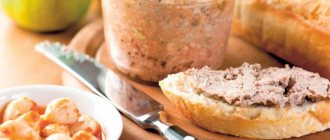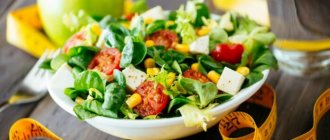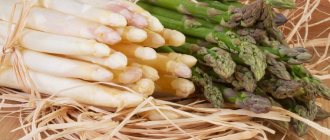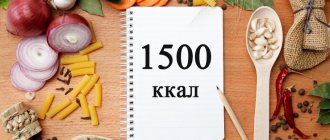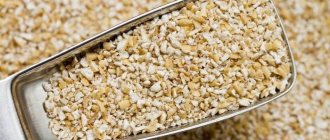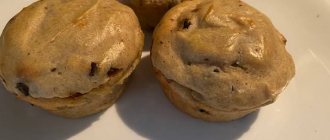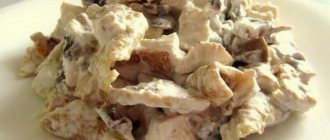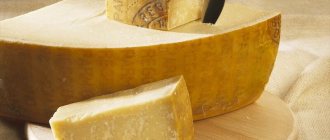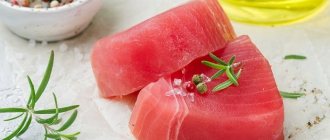Pate is a culinary preparation of creamy consistency obtained at home or industrially from various ingredients, such as:
- pork;
- beef;
- fish (tuna);
- ham;
- liver;
- butter;
- sour cream;
- spices;
- nutritional supplements;
- flavorings.
The most famous type of pate is “paté de foie gras”, which is made from goose or duck liver (and only from certain species of these birds raised for this purpose). The liver obtained from these poultry is hypertrophied and saturated with fat (liver steatosis). This liver is transformed into a paste by mixing with:
- butter;
- milk;
- sometimes with rare and expensive mushrooms (truffles).
This delicacy (meaning "paté de foie gras") is usually eaten spread on toast as a snack. As a rule, the price of such pleasure is considerable.
Pate
And in fact, can a mass that is sold in small cans be called a real pate - you can find such a product in any supermarket.
In Russia, pate was tried in the 18th century, and at first chefs were invited from France to prepare it - of course, only aristocrats could afford it. Today, few people remember that in his “Onegin” Pushkin describes “Strasbourg’s imperishable pie” - when we read these lines at school, we hardly thought that the author was referring specifically to pate - however, one of those products that we are only talking about today we hear: it included hazel grouse, truffles, and other elite products - few of us even tried them.
The word "pate" comes from the word "pasta" - this is Latin, and means something like "pureed (or crushed) and wrapped in dough" - something like that - so the pie was called pate.
Recipe for pate with prunes
Required:
- beef liver - 330 g;
- onion - 85 g;
- sweet cream butter 82% - 75 g;
- prunes - 5 pcs.;
- lard - 25 g;
- dry wine - 45 g;
- cloves - 1.5 g;
- nutmeg - 1.2 g;
- thyme, thyme - 2 g each;
- salt - 2 g.
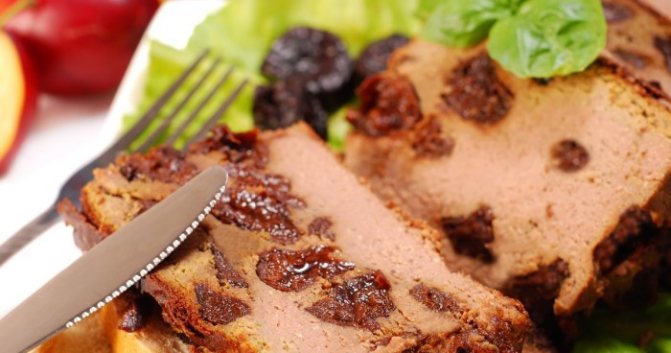
. Preparation:
- Add all the spices to the hot fat and fry a little so that the oil becomes saturated with aroma.
- Remove large particles of spices and add coarsely chopped onion, fry for about 3 minutes.
- Add liver, cut into pieces, to the half-finished onion and fry for 15 minutes.
- Add prunes, cut into thin strips, pour in the wine, add a little salt to everything, stir and simmer for 25 minutes so that the aroma of the wine permeates the ingredients.
- Transfer all products into a large container and cool.
- Add butter and whip up a fluffy pate.
- If desired, you can decorate everything with herbs and cool.
What types of pates are there?
In fact, there are different types of pates, and we don’t know about some of them at all. Pate baked in dough
the French cooked in such a way that the dough could then be thrown away - this was wastefulness, especially in the 18th century, when the people of France often went hungry, but such were aristocratic whims. The filling was minced meat mixed with herbs, vegetables, fats, and later pates began to be prepared from the meat of small birds and other ingredients, and they learned to bake them in foil or special forms; They ate pates hot and cold.
Why I love my robot vacuum cleaner so much: sharing my own experience
Another variety is stewed pate
, and it was usually made from pork - most likely, it was invented even earlier. The French called the pate “Rillon”, and it must contain pork - this is the main component, as well as less fatty meat - hare, poultry, etc. The meat is stewed for a long time with seasonings and spices, and then poured into pots or bowls , and for several weeks they are put in a cold place - a glacier: this is what ice cellars used to be called, and it must be said that the food in them was preserved much longer than in modern refrigerators, and did not lose its quality. It is easy to notice that this is a less refined dish, and in general it is somewhat reminiscent of our stew or jelly - it was loved by wealthy French peasants and rich bourgeois.
Pate prepared in pots - terrine
, on the contrary, is distinguished by its “delicacy” - no additives are used in its preparation: in addition to minced meat of various varieties, these are mushrooms, herbs and spices, pickles, lingonberries, pineapples, oranges, cherries, juniper berries, and even alcoholic ingredients - armagnac, etc. These pates are baked in the oven in different pots - glass and ceramic, and they are also cooked in a water bath, and fat or jelly is poured on top.
Terrine pates can be not only meat: they are made from fish, seafood, mushrooms and vegetables, and even sweet products - here French chefs set no limits for imagination.
What do we call pate?
Today we have begun to learn more, but earlier, in “Soviet” times, pates called exactly what is still sold in jars today - a carefully crushed mass, almost a puree, usually from liver, or with the addition of meat. Such pates are made from already prepared products (fried, boiled, stewed), and are crushed using various meat grinders, food processors, rubbed through a sieve, etc.
At home you can make pates from any product: classic - from liver; from pork and chicken, from cheese and fish, their green vegetables and potatoes, mushrooms and fruits - of course, such pates cannot be stored - they must be eaten within a few hours.
The world-famous dish - foie gras pate - made from fatty liver, mainly duck and goose, was invented in the last quarter of the 18th century by a French chef who served the mayor of Strasbourg - hence the name “Strasbourg pie”. Experts, however, believe that similar pates were prepared before, and the cook just slightly changed the recipe - and the appetizer quickly became famous. We won’t talk here about the intricacies of cooking foie gras, and especially about raising birds for it - enough has been written about this today. We will try to talk a little about the pate that you can buy from us today, as well as about preparing pates at home - with modern kitchen appliances this is not at all difficult.
Can there be harm from eating different types of pate?
Speaking about the harmful effects of pate varieties on the body, it is necessary to dwell on several points.
- Frequent consumption of pates made from liver or meat of poultry and animals, fish (that is, from products high in protein) can negatively affect kidney function and cause exacerbation of chronic bladder diseases. Excessive amounts of protein foods of animal origin contribute to the accumulation of purines (uric acid), which can cause various ailments. For example, older people may experience worsening arthritis and development of gout.
- Pates have a high cholesterol content . Of all the varieties of this dish, the leader is the most delicious representative - goose liver pate. It contains 530 mg of cholesterol, and chicken - 135 mg. And this is with recommended doses of up to 300 mg per day for a healthy person, and no more than 150 mg for heart problems.
- When talking about pork rillette, you need to remember that the product contains a large amount of fat and is quite high in calories.
- Most often, pate is consumed with bread, which increases the level of the glycemic index. People with spikes in blood sugar levels need to remember this.
- Frequent consumption of canned pates sold in stores can harm the body. Thickeners, preservatives and other related ingredients cannot be beneficial. The simplest thing that threatens lovers of such food is obesity .
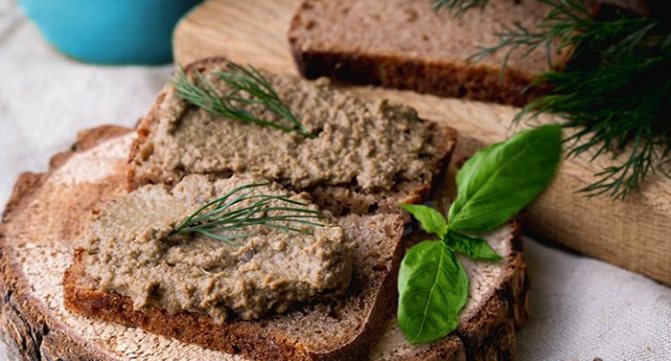
The benefits and harms of pate
Is pate healthy or harmful as a food product?
Opinions, as always, are divided, but one thing can be said for sure: pate is a real product made from natural ingredients, which means it has benefits - it just depends on the method of preparation and storage conditions, if the pate must be stored for some time time. In Russia, pates are usually prepared from the liver of livestock and poultry, and these products are very rich in vitamins - in particular vitamin A; minerals and many other nutrients; They also have a lot of calories, but they are not heavy on the stomach like meat or fat.
Therefore, many nutritionists recommend eating pates even for breakfast - little by little, in the form of sandwiches or with salads - after this there will be no heaviness in the stomach, but the feeling of fullness will remain for many hours.
Vegetable (lenten) pates sold in stores
Some of you are wondering if you can eat vegetable (lenten) pate. If you are counting on a composition that is less harmful to the body compared to meat pates, then you are mistaken. Vegetable pate products are identical in composition to meat pate products, except that they do not contain meat.
Composition of lean (vegetable) pates
Their main ingredients are:
- water;
- non-hydrogenated or hydrogenated vegetable oils (margarine);
- soy protein;
- iodized salt;
- spice extracts;
- mustard;
- flavorings;
- stabilizers (polyphosphates E 452);
- emulsifiers (fatty acid salts E 470);
- thickeners (guar gum E 412, carrageenan E 407);
- wheat and corn starch;
- glucose syrup;
- Sahara;
- flavor enhancers (monosodium glutamate E 621);
- dehydrated vegetables;
- antioxidants (ascorbic acid E 300);
- acidifier (citric acid E 330);
- carob gum (E 410);
- dyes (caramel E 150, carmine E 120);
- paprika extract;
- allergens: gluten;
- celery;
- mustard;
- soybeans
Some meatless pates contain components of animal origin , which is why it is recommended to carefully read their composition before consumption. Examples of animal ingredients in meatless pates:
- protein hydrolysates;
- serum;
- whey powder;
- albumen;
- lactose;
- carmine dye (E 120);
- some margarines.
Contraindications for Lenten pates
As you noticed, in terms of nutritional properties, lean pate products are no better than meat pate products, and may even contain more nutritional additives! Diabetics should be especially careful because the vegetable pate contains sugar. That's why they should limit their consumption.
Due to the high content of vegetable fats, these products are contraindicated for the following disorders :
- dyslipidemia;
- cardiovascular diseases;
- overweight.
When eating such foods, you should take into account high concentrations of sugars, salt and fats. Thus, overusing them is a risky proposition!
Those suffering from celiac disease are contraindicated to consume lean (vegetable) pate products due to the gluten content.
The presence of food additives in them (for example, monosodium glutamate E 621) makes them unsuitable for the following categories of consumers:
- pregnant women;
- patients with cardiovascular diseases;
- children;
- suffering from hypoglycemia.
As mentioned above, the polyphosphates used to stabilize the water in the pate make it very difficult for calcium to be absorbed into the bones. Therefore, this category of products is contraindicated:
- those suffering from osteoporosis;
- old people;
- teenagers;
- children.
If you want to eat pate products, it is best to prepare them at home. By controlling the composition and quality of the ingredients used, you will receive a high-quality and nutritious product.
How to choose a pate
If you do not prepare pate, but buy it in a store, you need to know how to choose it
. Traditionally, pate is packaged in cans, and it can be stored for several years - no preservatives are needed for this, but today the packaging has changed - manufacturers are trying to minimize costs. The pates are packaged in polymer shells, and their shelf life is sharply reduced: a month at most; if the packaging indicates that it can be stored for six months or more, this means that the manufacturer did not spare any preservatives.
Opened pate can be stored in the refrigerator for a maximum of 5 days. The liver in the pate should be 55% or more: usually it is beef liver or poultry liver.
The jar with the pate should be smooth and neat, without streaks, and the pate itself should have a uniform consistency and light brown color (it may be slightly grayish or beige - this is normal). The beautiful pink or dark brown color of the product indicates that it contains a lot of dyes and other additives, but a good pate has only 5 main ingredients: liver, meat, salt, butter and spices - this product is produced in accordance with GOST 12139-77. The “correct” pate smells like natural spices, but the taste may be slightly bitter - this is typical for any liver products.
Chicken liver pate
Ingredients:
- chicken liver – 1 kg;
- lard – 70 g;
- butter – 50 g;
- carrots – 2 pcs;
- onions – 1 piece;
- salt and spices to taste.
Preparation:
The lard is cut into thin slices, the onion is finely chopped and fried in a frying pan. The carrots are boiled, grated and added to the onions and lard. The chicken liver is scalded, chopped and added to the total mass and simmered until cooked. At the end salt and spices are added. The finished mass is passed through a meat grinder 2-3 times, butter is added and beaten. Chicken liver pate is ready.
Homemade pate
As already said, it is quite easy to prepare pate at home today, but we will not give recipes for meat pates here: everyone is used to eating them, and such recipes are not difficult to find, besides, we already consume a lot of meat - such is the food culture that has developed in Russia today .
There is an amazingly healthy and even medicinal product - zucchini, and the pate they make is wonderful, light and very tasty. A couple of ripe zucchini should be cut into slices, fried together with onion (1 large onion), add 3 crushed cloves of garlic, cool slightly and puree in a blender. Then add the remaining ingredients: mascarpone or just your favorite cheese, grated on a fine grater (150 g), toasted and chopped almonds (50 g) and 1 tbsp. low-fat mayonnaise. Mix everything thoroughly and refrigerate for half an hour. You can serve it on a plate, on toast or croutons.
You can prepare pates from onions and cucumbers, nuts, cheese and bell peppers, green leafy vegetables and edible herbs, beets, cheese and garlic, tomatoes and eggs, and mushroom pate turns out to be so tasty and piquant that few people believe that it was prepared without meat. Of course, you should also know how to cook meat pates, and most importantly, eat them correctly, enjoying their taste and receiving only benefits.
Article protected by copyright and related rights. When using or reprinting material, an active link to the women's website inmoment.ru is required!
Liver pate roll
Ingredients:
- pork liver – 1 kg;
- onion – 1 piece;
- carrots – 1 piece;
- pork lard – 300 g;
- butter – 200 g;
- chicken egg – 8 pcs;
- salt – 1.5 tsp;
- ground black pepper to taste.
Preparation:
The lard is cut into small pieces. The liver is washed, dried with a towel, and cut into medium-sized pieces. The lard is fried in a frying pan until the fat is rendered, then the liver is added. The carrots are grated, the onions are peeled and cut into rings, added to the liver and fried until tender, stirring constantly. At the end, the mass is peppered and salted, cooled and passed through a meat grinder 2-3 times. Boil the eggs, peel them and remove the yolks (whites are not needed). The yolks are ground into a fluffy mass, combined with butter and thoroughly ground. The liver pate is spread on a sheet of foil in a thin and even layer, the surface is greased with a mixture of yolks and butter, after which it is rolled into a roll, carefully and gradually removing the foil. The roll is cut into two parts and the edges are smoothed. The roll is packed in foil and put in the refrigerator for 6-8 hours. The liver roll is ready.
Possible harm
Unfortunately, beef liver has not only beneficial properties, but also contraindications.
This product is not recommended for the following conditions:
- atherosclerosis;
- gout;
- joint diseases.
Even if you have no contraindications, I recommend following the measure and remembering doctors’ recommendations regarding the consumption rate of this product.
Cholesterol
The presence of bad cholesterol in the liver is one of the main reasons why this delicacy cannot be present in our diet every day. Of course, the amount of cholesterol in one serving is small, and the harm from it can only appear if you really abuse the liver.
However, people with heart disease or those who are overweight should be particularly careful to ensure that the amount of liver they consume does not exceed the norms recommended by doctors.
Toxins
Another reason for reducing the amount of liver in the menu may be the fact that, being a filtering organ, it can accumulate various toxins and therefore become a dangerous product. This statement is only true if the animal has received a lot of antibiotics or other medications. In order to protect yourself, it is enough to be careful about who you buy the delicacy from, and choose only those farmers or suppliers you trust.
